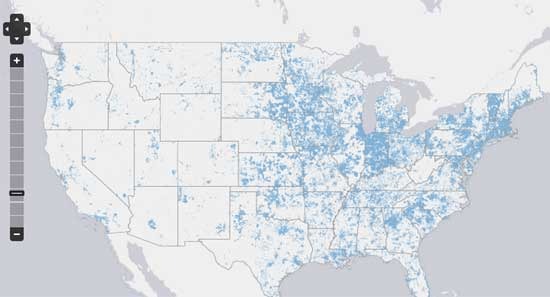Fiber Optics: Past Copper
Most of the active connections to this globe spanning network we all love to hate come in the form of cable or DSL. Modulated electric signals get transmitted over metal wires, coaxial or twisted pair respectively. These technologies transmit the internet as most experience it. Verizon has begun to break down this model with it's FiOS fiber optic lines, but they have been really slow to roll out. They've only managed to cover 10% of the households in the United States. AT&T isn't doing much better at getting Fiber to the people, U-Verse (where most AT&T fiber customers fall under) has even fewer subscribers than FiOS. Fiber-optics, while ten or a hundred times faster than the connection you're probably using, isn't available most places, yet. We wrote about Google's Fiber Project earlier today.
Data speed is like oxygen, right? Oxygen you take for granted until it disappears. And then it becomes everything.
Cable and DSL weren't originally designed to transmit and receive digital signals. Originally it was all just the system of copper lines that transmitted analog signals for commercial telephone systems. DSL takes advantage of some property of electromagnetism that I don't entirely understand to send the signal through the field surrounding the twisted pair. Cable internet, likewise, was bolted-on to the Cable TV system after-the-fact.
It's not there already because the physical infrastructure that would actually funnel all of the clips of Katy Perry and Justin Bieber to millions of computers through laser beams just doesn't exist. The beams are not there yet. This allows for some really smart and creative business minds (a.k.a. Google) to have an opportunity to fill these gaps, demand seems to be growing just a little bit faster than the old telecom giants are able to keep up. This is why this project is so important, this allows Google to begin investing some real capital into the Real Stuff that makes up the internet. This market has massive barriers to entry, and Google is taking the leap over the wall.
It's not all on the telecoms to make these changes to the US network. The Federal government has gotten involved in spreading high-speed access. They have a website that promotes, "Broadband is the great infrastructure challenge of the early 21st century." As a part of the National Broadband Plan those fine folks put together this interactive map of broadband coverage throughout the US.

Note though, Google's entire project hangs on the approval of KC's Board of Commissioners. I wonder how many telecommunications lobbyists linked with AT&T and/or Verizon made appointments, phone calls, or visits down to KC's City Hall today?
This could give Google the leg-up it needs to start building it's own broadband empire in infrastructure, the only place it matters. Google has been looking to open large parts of the US telecommunications networks, starting with the FCC Auction for the ~ MHz spectrum last year. They have been unsuccessful thus far. It doesn't really matter that much to consumers which company gets to provide them with fiber. That's a battle that's going to be fought in board rooms and City Council meetings over the next decade or so. But the best part of this whole project, if it goes through... This will link the entire town of Kansas City together with hair-thin fibers of glass and laser beams, and that's a step in the right direction.
